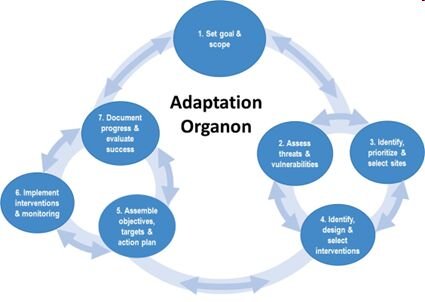About the Adaptation Organon for Resilient Natural Resources
An organon is a thought instrument or system of logic that unifies a body of scientific principles. The Adaptation Organon (AO) for Resilient Natural Resources is a system for considering climate change and other environmental information to inform adaptation and improve natural resource management for resilience and sustainability. “Adaptation” refers to adjustment in natural or human systems to a new or changing environment that exploits beneficial opportunities or moderates negative effects. To inform adaptation, the AO serves as a: logic model; information system; planning and evaluation framework; and guide for communication and brainstorming among project partners. The structured thought process helps with getting started, getting unstuck, and delving deeper to fulfill the key components of planning and implementation to achieve successful adaptation.

The AO is for researchers, practitioners, decision makers, educators, and anyone else seeking an introduction to, and examples of, resilience-based adaptation planning. It has multiple uses, from basic orientation and education drawing on a variety of ecosystem examples, to program evaluation, to detailed project planning. For program evaluation, the AO is used with decision makers to brainstorm improved adaptation of existing work, identify work that is still needed, and evaluate how internal work links together across steps to improve adaptation efforts. For detailed project planning, the AO is used with a working group of subject matter experts to guide systematic design and action planning processes to achieve a particular program or project goal.
The AO contains real-world examples of science-to-implementation projects focused on corals, salmon refugia, stream monitoring, and salt marsh systems. This allows users to compare and inform their own work based on other successful efforts. The AO organizes methods, approaches, resources, and tools according to seven key components of adaptation planning:
- Set Goal & Scope
- Assess Threats & Vulnerabilities
- Identify, Prioritize, & Select Sites
- Identify, Design, & Select Interventions
- Assemble Objectives, Targets, & Action Plan
- Implement Interventions & Monitoring
- Document Progress & Evaluate Success
The key components inform each other iteratively, such that users are encouraged to regularly revisit and further refine components through time as new information from other components becomes available. Key components can be explored at any time in a user’s process, allowing for utilization of the AO to evaluate ongoing or past efforts, as well as plan new ones. While key components do not necessarily need to be completed by a single team or in a rigid order, all elements should be addressed for rigorous resilience-based adaptation.
History of Organon
Below is a list of important milestones for Adaptation Organon.
| Date | Milestone |
|---|---|
| Aug 2023 | Adaptation Organon provided on the Global Change Explorer (GCX) website. |
| Jul 2023 | Organon v.2 completed |
| Jan 2023 | Technical Advisory Group (TAG) review meeting |
| Sep 2022 | Organon v.1 completed |
| Jan - Sep 2022 | TAG quarterly co-production meetings |
| Sep 2021 | Organon framework completed |
| Jan - Sep 2021 | TAG quarterly co-production meetings |
| Sep 2020 | Project kickoff |
Publications
EPA Report
- West, J., A. Hamilton, J. Stamp, AND I. Reilly. Adaptation Planning Organon for Resilient Natural Resources. Presented at In-Person Meeting of the Organon Technical Advisory Group, Washington, DC, October 24 - 25, 2023.
